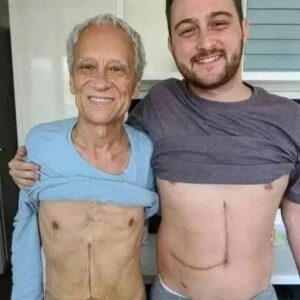
The Silent Guardian
The morning sun filtered through the tall windows of the family courthouse, casting long shadows across the polished marble floors. Nine-year-old Emma Chen sat in the hallway outside Judge Harrison’s chambers, her small hands nervously smoothing the fabric of her best dress—a navy blue one with tiny white stars that her foster mother had helped her pick out the night before. Beside her, a large German Shepherd named Atlas lay perfectly still, his intelligent brown eyes scanning the faces of every person who walked past.
Emma had been living with the Morrison family for fourteen months now, ever since the night police officers had found her hiding in a closet while her stepfather Marcus was arrested for domestic violence. The charges against Marcus had been serious—assault, child endangerment, and multiple violations of restraining orders—but somehow his lawyer had managed to get him released on probation after serving only six months in county jail.
Now Marcus was petitioning the court for custody of Emma, claiming he had completed anger management classes and substance abuse counseling. He argued that as her legal guardian—having married Emma’s mother shortly before her death in a car accident two years earlier—he had every right to raise his stepdaughter. What the court didn’t fully understand was that Emma’s silence wasn’t just shyness or grief. It was survival.
“Emma?” A gentle voice interrupted her thoughts. Dr. Sarah Walsh, the child psychologist who had been working with her since the placement with the Morrisons, approached with a warm smile. “How are you feeling about today?”
Emma’s response was barely a whisper. “Scared.”
Atlas immediately shifted closer to her, his massive head resting against her leg. The dog had been assigned as Emma’s therapy companion eight months ago, when traditional counseling methods weren’t helping her process the trauma she’d experienced. Unlike the psychiatrists and social workers who asked direct questions that Emma couldn’t answer, Atlas simply provided presence—a calm, protective energy that allowed her to feel safe enough to begin healing.
The relationship between Emma and Atlas had developed slowly but profoundly. At first, she’d been afraid of his size, having learned to fear anything large or potentially threatening. But Atlas had been specially trained to work with trauma survivors, and he possessed an almost supernatural ability to read human emotional states. He never approached too quickly, never demanded attention, and seemed to understand that trust had to be earned gradually.
The breakthrough in their relationship came during a thunderstorm three months after Atlas’s arrival. Emma had been having a particularly difficult night, plagued by nightmares about Marcus and unable to settle into sleep. When lightning began flashing outside her bedroom window, she’d started hyperventilating—a response that reminded her of the nights when Marcus would come home drunk and angry.
Atlas, who usually slept in the hallway outside her room, had somehow sensed her distress. Without being called or invited, he’d pushed open her slightly ajar door and positioned himself between her bed and the window. Then he’d done something remarkable—he’d begun a low, rhythmic breathing pattern that was designed to help humans regulate their own breathing during panic attacks.
Emma had watched in amazement as the large dog demonstrated the calming technique she’d been unable to master in months of therapy sessions. Slowly, almost unconsciously, she’d begun to match his breathing rhythm. Within ten minutes, her panic had subsided, and she’d fallen asleep with her hand resting on Atlas’s shoulder.
From that night forward, Emma and Atlas developed their own communication system. She discovered that Atlas could distinguish between different types of distress and respond accordingly. When she felt general anxiety, he would move closer and offer his presence. When specific trauma memories surfaced, he would position himself as a physical barrier between Emma and whatever triggered her fear. And when she felt completely overwhelmed, he would perform the breathing exercise that helped her regain control.
But it was Emma who taught Atlas the most crucial skill of all—how to recognize when someone represented a genuine threat to her safety.
The process had been unintentional at first. During supervised visits with various extended family members, Emma had unconsciously developed physical responses to people who made her feel unsafe. A slight tensing of her shoulders when her maternal uncle raised his voice. A subtle step backward when a family friend stood too close. A specific way of positioning her hands when someone’s behavior reminded her of Marcus’s unpredictable moods.
Atlas, with his intensive training in reading human body language, had learned to recognize these signals. More importantly, he’d learned to respond to them in ways that provided Emma with protection and advocacy she couldn’t provide for herself.
The court hearing was scheduled for ten o’clock, and as they waited in the hallway, Emma could see Marcus through the glass doors of the courtroom. He looked different from the man she remembered—cleaner, more controlled, wearing a suit that made him appear respectable and reformed. But when he turned and caught sight of her through the glass, his expression shifted for just a moment. It was a subtle change—a hardening around his eyes, a slight curl of his lip—that lasted only seconds before he resumed his carefully composed demeanor.
But Emma saw it. And more importantly, Atlas saw her reaction to it.
The German Shepherd’s entire body changed posture. His ears pricked forward, his muscles tensed, and his gaze locked onto Marcus with laser-like focus. He didn’t growl or show obvious signs of aggression, but his message was clear to anyone who understood canine behavior: this person represented a threat to his charge.
“I think we should go in now,” said Rebecca Martinez, Emma’s court-appointed advocate. Rebecca had been fighting for Emma’s interests for over a year, and she understood better than most adults how difficult it was for traumatized children to articulate their fears in legal settings.
The courtroom was smaller than Emma had expected, with dark wood paneling and tall windows that let in streams of autumn sunlight. Judge Harrison, a woman in her fifties with graying hair and kind eyes, sat behind an imposing bench that made Emma feel even smaller than usual.
Marcus sat at a table with his attorney, a sharp-dressed man who had already begun arguing that his client deserved a chance to rebuild his relationship with his stepdaughter. “Your Honor, Mr. Reynolds has completed every requirement set forth by this court. He has attended anger management classes, maintained sobriety for fourteen months, and secured stable housing and employment. The bond between a parent and child should not be severed based on past mistakes that have been addressed through proper rehabilitation.”
Emma sat at a table across the room with Rebecca and Dr. Walsh, Atlas lying quietly beside her chair. The dog’s presence was unusual in a courtroom setting, but Judge Harrison had reviewed his credentials and the documentation of his role in Emma’s therapeutic process. She had granted special permission for Atlas to attend the hearing, recognizing that Emma might not be able to participate in the proceedings without his support.
The first hour of the hearing consisted of testimony from social workers, therapists, and character witnesses. Marcus’s rehabilitation counselor spoke about his progress in anger management classes and his expressed commitment to being a better guardian. His employer testified that he had been a reliable worker for the past eight months, showing up consistently and maintaining professional relationships with colleagues.
“Mr. Reynolds has demonstrated genuine remorse for his past behavior,” testified Dr. Patricia Kim, who had conducted his court-mandated therapy sessions. “He has made significant progress in understanding the impact of his actions and developing healthier coping mechanisms for stress and conflict resolution.”
But Dr. Walsh painted a different picture when she took the stand to discuss Emma’s progress and needs. “Emma has made remarkable strides in her healing process over the past fourteen months,” she explained. “However, she continues to experience significant trauma responses related to her experiences with Mr. Reynolds. Her anxiety levels increase dramatically whenever the possibility of returning to his custody is discussed.”
Marcus’s attorney was quick to challenge this assessment. “Dr. Walsh, isn’t it possible that Emma’s reluctance to return to her legal guardian is influenced by her attachment to her current foster family? Children often resist change, even positive change, when they’ve formed emotional bonds elsewhere.”
Dr. Walsh had anticipated this line of questioning. “While attachment to foster families can certainly create anxiety about transitions, Emma’s responses to Mr. Reynolds specifically are consistent with trauma reactions rather than general separation anxiety. Her behavior patterns suggest she perceives him as a source of danger rather than security.”
“But you haven’t observed Emma and Mr. Reynolds together recently,” the attorney pressed. “How can you assess their current relationship dynamic based solely on her responses to the abstract concept of returning to his custody?”
It was a fair point, and one that highlighted the central challenge of Emma’s case. Because she was largely nonverbal about her experiences and because Marcus had successfully completed his rehabilitation requirements, the court had limited concrete evidence to support keeping them separated.
Judge Harrison had been listening carefully to all the testimony, reviewing case files and psychological evaluations with the thoroughness that such decisions required. “I would like to observe an interaction between Emma and Mr. Reynolds,” she announced. “Nothing formal or lengthy, but I think it would be helpful to see how they communicate with each other after this period of separation.”
Emma’s heart began racing the moment she heard these words. Rebecca had prepared her for the possibility that she might be asked to interact with Marcus, but knowing it could happen and actually facing it were entirely different experiences.
“Emma,” Judge Harrison said gently, “I’m going to ask Mr. Reynolds to come over and say hello to you. You don’t have to say anything back if you don’t want to, but I’d like to see how you two get along. Is that okay?”
Emma nodded because she knew that’s what was expected, but her entire body tensed with anticipation. Atlas, who had been lying calmly throughout the hearing, immediately picked up on her emotional shift. His head lifted, his ears pricked forward, and his attention focused on Emma’s face as he read the subtle signs of her distress.
Marcus stood and approached their table with the careful movements of someone trying to appear non-threatening. He had clearly been coached on how to interact with Emma in this setting—his voice was soft, his posture was relaxed, and his expression was designed to convey warmth and regret.
“Hi, Emma,” he said, stopping about three feet away from her chair. “You look really good. I’ve missed you.”
Emma’s response was barely audible. “Hi.”
“I know things were really hard before,” Marcus continued, his voice carrying what sounded like genuine remorse. “I want you to know that I’ve been working really hard to get better. I’ve learned a lot about myself, and I want to make things right between us.”
As he spoke, Emma’s body language began to change in ways that were barely perceptible to most observers. Her shoulders drew up slightly, her breathing became more shallow, and her hands, which had been resting on her lap, moved to grip the edge of her chair. They were subtle signals, the kind that traumatized children learn to suppress to avoid making their abusers angry.
But Atlas had been trained to recognize exactly these types of responses. More importantly, Emma had unconsciously taught him that these particular physical changes meant she was encountering the specific source of her trauma.
The German Shepherd stood up slowly, his movement fluid but deliberate. He positioned himself between Emma and Marcus, not aggressively but unmistakably. His body language was alert but controlled—he wasn’t showing teeth or growling, but every line of his posture communicated protection and vigilance.
Marcus took a step back, clearly uncomfortable with the dog’s attention. “I don’t understand why she needs that animal,” he said to Judge Harrison. “Dogs can be unpredictable, especially around children.”
The comment was revealing in ways Marcus probably didn’t intend. Judge Harrison had been observing the interaction carefully, and she had noticed the precise timing of Atlas’s response to Emma’s subtle distress signals.
“Mr. Reynolds,” she said, “Atlas is a highly trained therapy dog who has been working with Emma for months. His behavior is actually quite predictable—he responds to Emma’s emotional needs. What I’m observing is that Emma appears to experience anxiety specifically in your presence, and Atlas is responding to that anxiety.”
“With respect, Your Honor,” Marcus’s attorney interjected, “we can’t base custody decisions on a dog’s behavior. Animals don’t understand legal relationships or family dynamics.”





